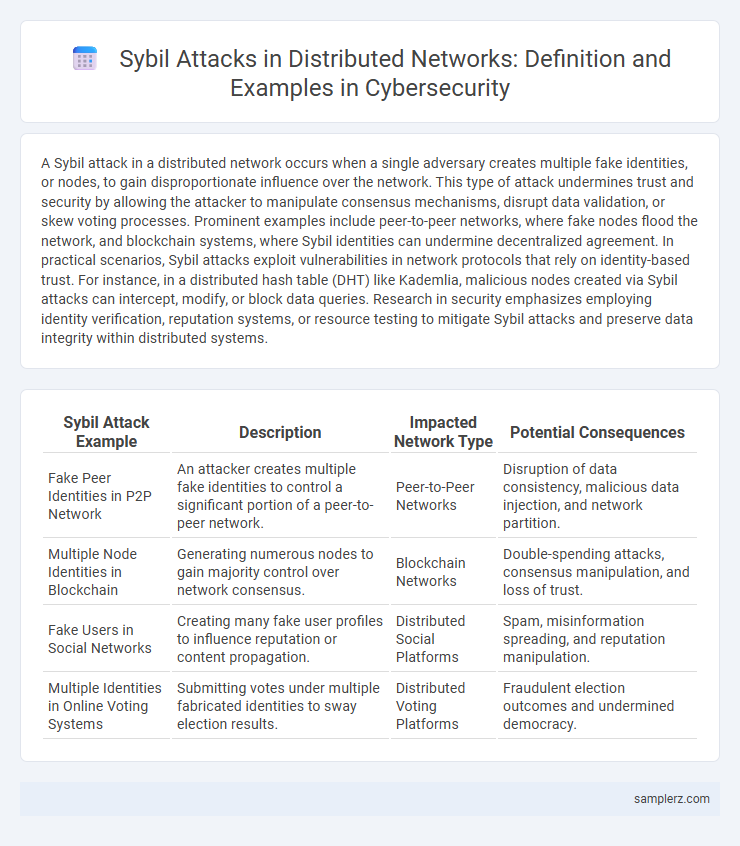A Sybil attack in a distributed network occurs when a single adversary creates multiple fake identities, or nodes, to gain disproportionate influence over the network. This type of attack undermines trust and security by allowing the attacker to manipulate consensus mechanisms, disrupt data validation, or skew voting processes. Prominent examples include peer-to-peer networks, where fake nodes flood the network, and blockchain systems, where Sybil identities can undermine decentralized agreement. In practical scenarios, Sybil attacks exploit vulnerabilities in network protocols that rely on identity-based trust. For instance, in a distributed hash table (DHT) like Kademlia, malicious nodes created via Sybil attacks can intercept, modify, or block data queries. Research in security emphasizes employing identity verification, reputation systems, or resource testing to mitigate Sybil attacks and preserve data integrity within distributed systems.
Table of Comparison
| Sybil Attack Example | Description | Impacted Network Type | Potential Consequences |
|---|---|---|---|
| Fake Peer Identities in P2P Network | An attacker creates multiple fake identities to control a significant portion of a peer-to-peer network. | Peer-to-Peer Networks | Disruption of data consistency, malicious data injection, and network partition. |
| Multiple Node Identities in Blockchain | Generating numerous nodes to gain majority control over network consensus. | Blockchain Networks | Double-spending attacks, consensus manipulation, and loss of trust. |
| Fake Users in Social Networks | Creating many fake user profiles to influence reputation or content propagation. | Distributed Social Platforms | Spam, misinformation spreading, and reputation manipulation. |
| Multiple Identities in Online Voting Systems | Submitting votes under multiple fabricated identities to sway election results. | Distributed Voting Platforms | Fraudulent election outcomes and undermined democracy. |
Understanding Sybil Attacks in Distributed Networks
Sybil attacks in distributed networks occur when a single adversary creates multiple fake identities to gain disproportionate influence over the network's operations, compromising consensus mechanisms and resource allocation. This type of attack undermines trust and security in peer-to-peer systems such as blockchain and sensor networks by distorting reputation scores or voting processes. Detecting Sybil nodes relies on analyzing network topology, resource testing, and behavioral patterns to maintain network integrity.
Real-World Examples of Sybil Attacks
Sybil attacks manifest in distributed networks like peer-to-peer systems where malicious nodes create numerous fake identities to manipulate consensus or disrupt services. A notable example includes the Bitcoin network, where attackers with excessive mining power generate fake nodes to influence transaction verification and network trust. Another case involves social media platforms employing decentralized verification, where Sybil identities spread misinformation or amplify fake accounts, undermining credibility and security.
How Sybil Nodes Compromise Network Integrity
Sybil nodes compromise network integrity by creating multiple fake identities that overwhelm honest nodes, disrupting consensus mechanisms in distributed networks. These malicious actors manipulate reputation systems, disable trust-based protocols, and enable fraudulent activities such as double-spending or data tampering. The presence of Sybil nodes weakens fault tolerance and network reliability, making detection and mitigation critical for maintaining security.
Case Study: Sybil Attack in Blockchain Systems
The Sybil attack in blockchain systems involves malicious nodes creating multiple fake identities to gain undue influence over the network consensus. This compromises the security and integrity of the distributed ledger by enabling double-spending and disrupting transaction validation. Notable cases include attacks on cryptocurrency platforms where adversaries exploited weak identity verification to manipulate voting mechanisms in Proof-of-Stake protocols.
Sybil Vulnerabilities in Peer-to-Peer Networks
Sybil vulnerabilities in peer-to-peer networks arise when a single adversary creates multiple fake identities to gain disproportionate influence, undermining trust and consensus mechanisms. These fake nodes manipulate resource allocation, disrupt routing protocols, and can facilitate attacks like eclipse or denial-of-service. Effective defenses include identity validation, reputation systems, and resource testing to limit the impact of Sybil nodes.
Social Network Exploitation via Sybil Attacks
Sybil attacks in distributed networks exploit social networks by creating multiple fake identities to manipulate trust-based systems and spread misinformation. These malicious entities undermine reputation systems, enabling fraudulent activities such as fake reviews, fraudulent votes, and influence manipulation. Detecting Sybil nodes relies on analyzing social graph properties like community structure and network connectivity patterns to maintain network integrity.
Sybil Attacks in Wireless Sensor Networks
Sybil attacks in wireless sensor networks exploit the network's reliance on node identity by creating multiple fake identities to disrupt routing, data aggregation, and resource allocation. Attackers can manipulate voting mechanisms, overwhelm the network with false data, and degrade overall system reliability, posing significant security challenges. Effective countermeasures include identity verification schemes, resource testing, and secure key management protocols specifically designed for resource-constrained sensor nodes.
Impact of Sybil Attacks on Trust and Reputation Systems
Sybil attacks in distributed networks undermine trust and reputation systems by creating multiple fake identities that manipulate voting outcomes and consensus mechanisms. These attacks distort reputation scores, enabling malicious nodes to gain undue influence and disrupt decision-making processes. The resulting erosion of trust compromises network reliability and security, making it difficult to distinguish between legitimate and fraudulent participants.
Mitigation Techniques for Sybil Attacks
Sybil attacks in distributed networks can be mitigated using identity validation techniques such as resource testing, where nodes prove their uniqueness through computational puzzles or cryptographic proofs. Reputation systems track node behavior over time to isolate and exclude malicious Sybil identities from the network. Network-based defenses like social graph analysis leverage trust relationships to detect and limit the influence of fake identities in peer-to-peer environments.
Future Trends in Defending Against Sybil Attacks
Future trends in defending against Sybil attacks in distributed networks emphasize the integration of machine learning algorithms to identify and isolate fake identities more effectively. Emerging blockchain-based identity verification systems provide decentralized and tamper-resistant authentication, enhancing network trustworthiness. Advances in reputation systems and cross-validation techniques further strengthen resistance to Sybil infiltration by continuously validating node behavior in real-time.

example of sybil in distributed network Infographic
 samplerz.com
samplerz.com